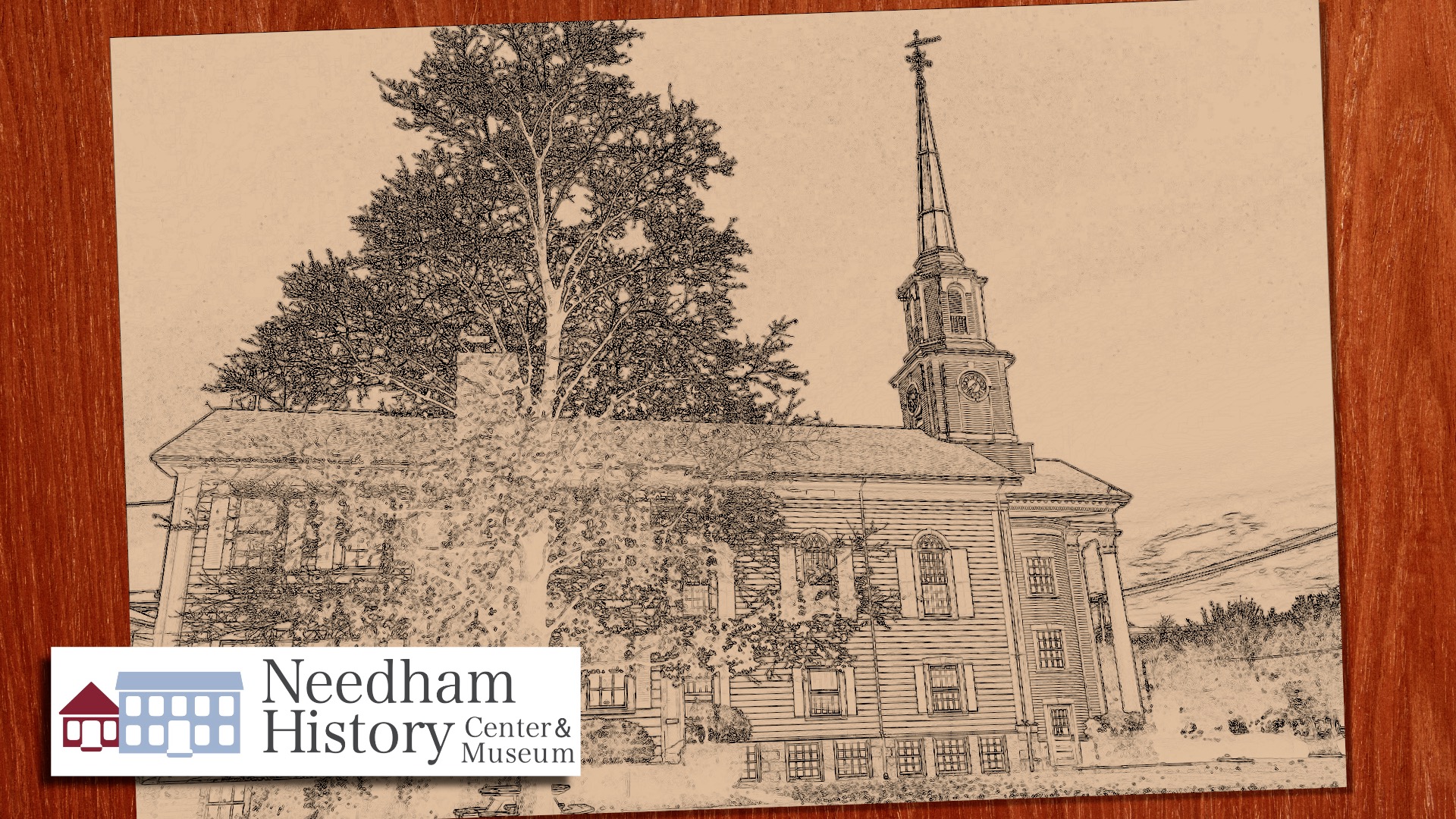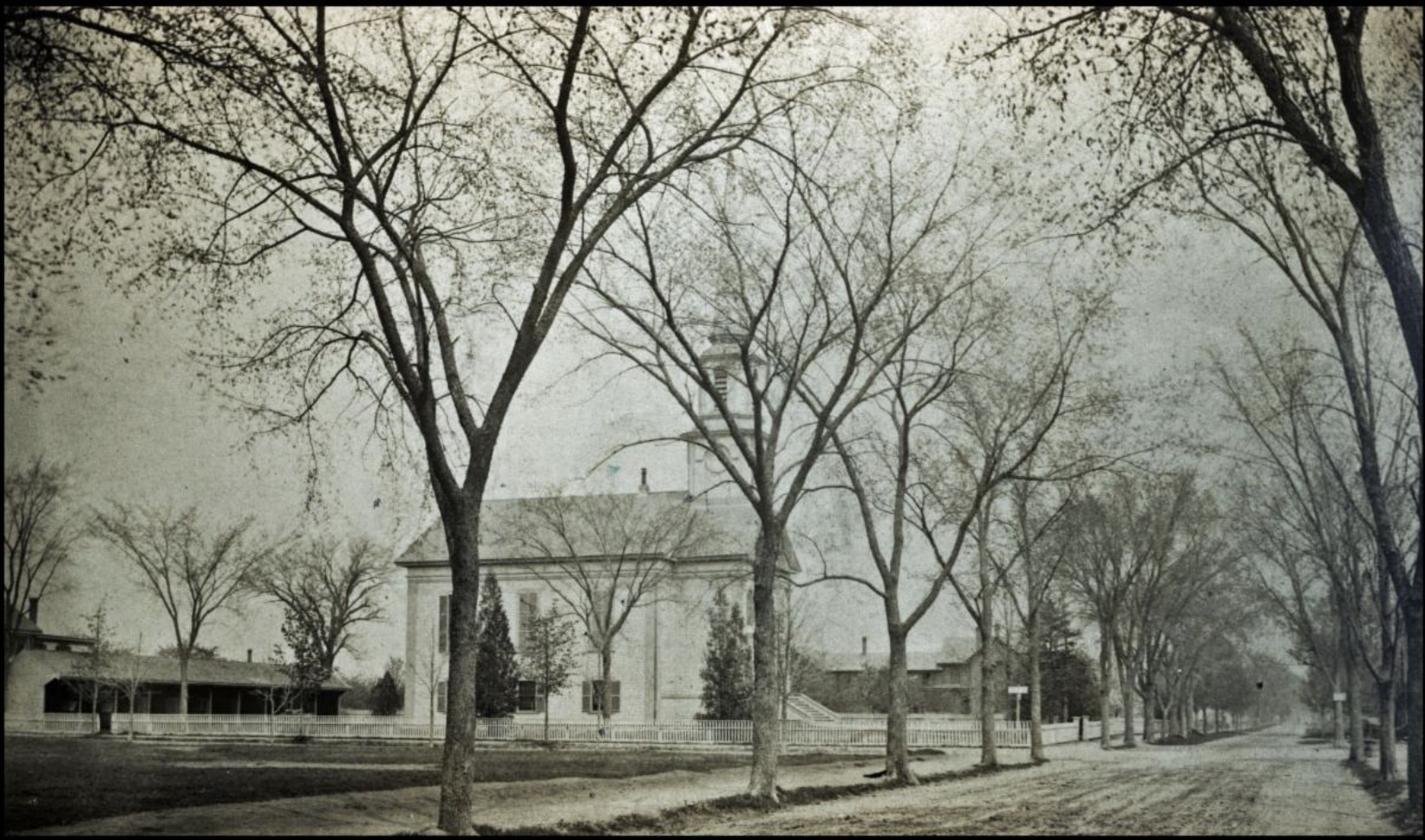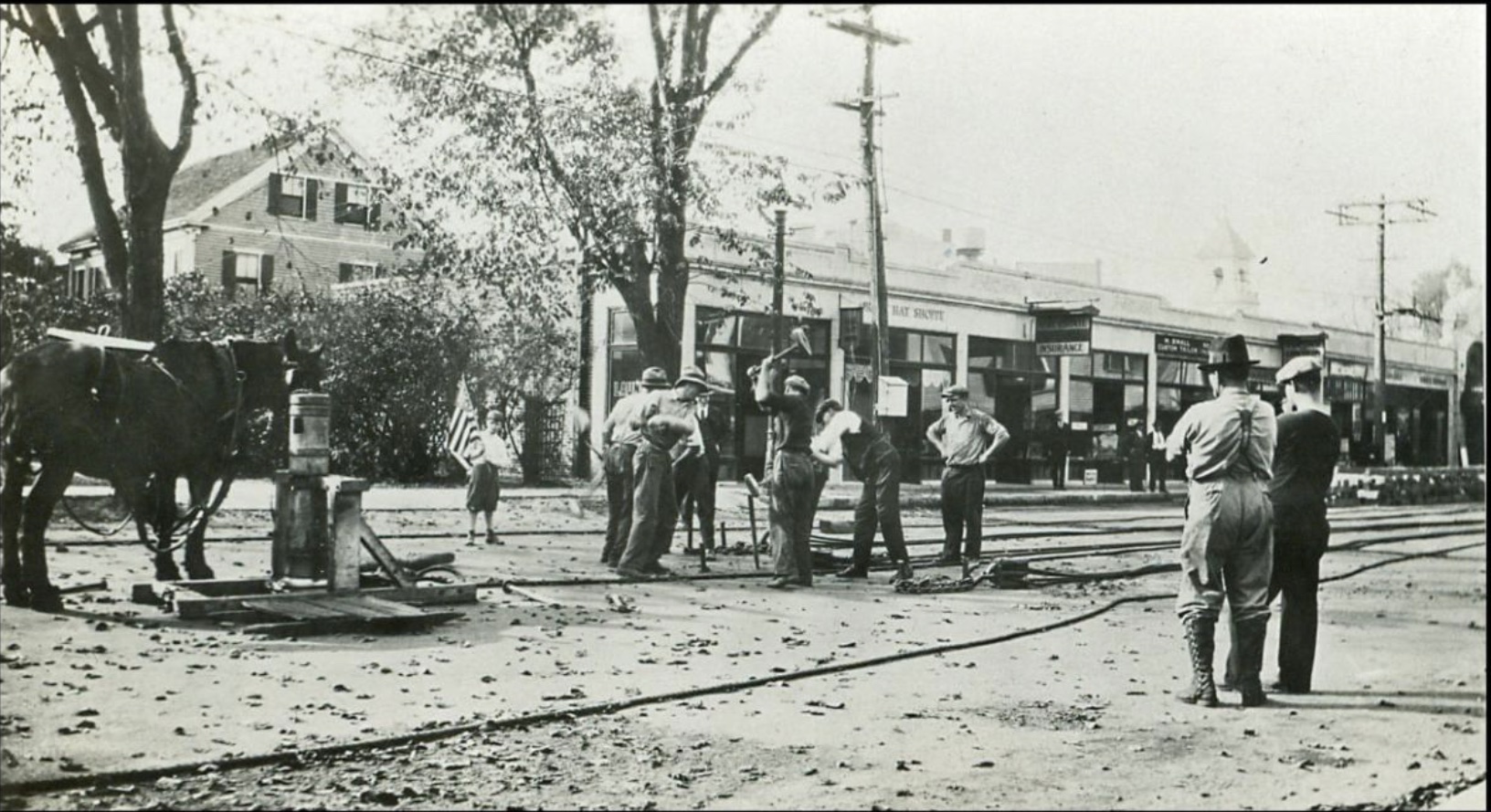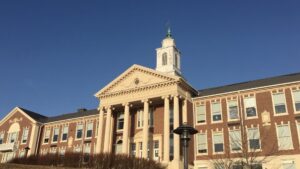
Needham History: Moving the Baptist Church
“it will be one of the finest…”

The first Baptist Church in its original location at the corner of Great Plain and Highland Avenues. The view is looking down GPA toward the east. The row of stalls to the left was for carriages (the parking lot of its day).
Moving the Baptist Church
When we first moved to Needham in 1991, our neighbor was a delightful gentleman named Bob Wyness. Bob loved to tell stories, so that first summer, he and I would hang out along the low fence between our yards (lazily watching my husband Michael dig the new garden) and he would tell us about Needham.
Bob had come to the United States from Aberdeen in the early 1920s. He worked as a shipbuilder in Scotland, but there was not much call for that here so he worked as a carpenter and builder. Later be became a contractor, and served in Needham as Building Inspector for many years. By time we met him, he was looking forward to his 90th birthday (which was a grand celebration). Bob had been on the team which built the odd second-floor sleeping porch on our house in 1924 (odd because there is no first floor to go with it – it just juts out from the bedroom and is supported on posts). He must have done a good job, because 100 years later it is still standing firm, and we still sleep there. He told us about every inhabitant of our house (in order!) It was Bob who first told us about Walter Queen, who owned the house in the 1920s; Cmdr. Queen was a Navy officer, Antarctic explorer, owner of the QP Signal Company on Hillside Avenue, and Needham Selectman (I think we own his skis?). He told us about Harold Putnam, attorney, Congressional aide, and Town Moderator, who owned our house in the 1950s. Bertha Walton, who turned our house into a private nursing home in the 1930s. So many great stories about our new home!
Bob also told us that he was on the team that moved the Baptist Church in 1928. Moved that huge church? That seemed a little incredible – but like all of the stories Bob told us, it was perfectly true.
We are used to seeing the First Baptist Church on its lawn on Great Plain Avenue, just across the street from the YMCA. It is a grand and traditional New England edifice, just the kind of church that would have been planted there in the Early Days and watched the town grow around it ever since.
The Baptist Church was indeed planted in the Early Days, but not in its current location. When first built (completed in 1872, but started years earlier) it was located on the corner of Highland and Great Plain Avenues. It was one of the earliest buildings constructed when the train came through the Great Plain and started to attract businesses into our current downtown. Many of the early Great Plain businesses were in fact owned by members of the church – Crossman, Sutton, Howland, Moseley.
The congregation is now, sadly, diminished, and the church has closed after more than 150 years. But in its day, it was one of the largest and most vibrant of the Needham church communities. Its rapid growth was the reason that it had to move. Early pictures show the church and its carriage barns and rectory pretty much filling up the space from the corner to what is now Crosby’s Jewelers and DePritzio’s Salon.
By 1928, the Baptist congregation was large enough that the church was running out of space. There was no more room to grow on their corner, since the adjacent lots had been built up for homes and stores. The building was also in need of significant repairs, and their familiar corner had become busy and noisy. They considered selling the church and its real estate and rebuilding elsewhere. In the end, the best solution was to move – to follow the example of their Unitarian friends across the street by lifting the church off its foundations and towing it to its current location at the corner of Great Plain Avenue and Warren Street. Unlike the Unitarians, the Baptists had the advantage of motorized vehicles, so their move only took a day or so. Still, it must have been pretty amazing to see this huge and venerable edifice cruising down GPA.
Moving a large building is a rare and daunting prospect for us, but it was actually fairly common in the 18th and 19th centuries. Unlike modern buildings, which are rebarred to the foundation, many old houses were just laid on level sills and relied on gravity to keep them in place. Since finished wood (both planks and trim) was very expensive, it was often more economical to move an existing structure than build a new one. Our own Mills House headquarters, for example, was lifted off its sill and moved to our Newman School location in 2005; and the house itself was originally built (1834) by reusing of other standing structures, one probably dating to the 18th century. We, of course, had the benefit of hydraulic lifts. In the 19th century they managed it with oxen and log rollers.
The three images below show scenes of moving the church – the cribbing, obstacles on GPA, the horse teams. The water pump near the horse in the top picture appears to be in the road (also in the last picture). I love the little boy with the flag! Is one of these men my friend Bob?


The church’s initial attempts to sell their property were unsuccessful, until the new Needham National Bank came looking for a site. The deal was brokered by Lloyd K Allen who was both a member of the church’s Executive Committee and a Director of the Needham National Bank. Built in 1930, it is currently the Santander Bank. The sale of the Highland corner lot provided enough money to purchase the new lot on the corner of Great Plain and Warren Street and cover part of the move and repairs; the rest was raised by the parishioners.
The church was moved in late October, 1928. The Needham Chronicle had a long article in its October 20th edition: “The event of importance this week has been the moving of the First Baptist Church…” Oddly, the move itself took up very little of the story (though they note that the Boston papers covered the event pretty comprehensively); most of their coverage was on the reasons for the move, based on an interview with Lloyd Allen.
There are, however, photographs, and these are pretty amazing. The church is raised on cribbing. A couple of the pictures show motor vehicles, but several also show horses wearing draft collars. The route was basically straight up Great Plain Avenue from Highland to Warren, but it was not all that simple. The road appears to be unpaved, and also maybe obstructed by a water pump (was that really in the middle of the road?) There were piles for dirt from the digging that had to be navigated around. Plus, the street was lined with new stores, built only a few years before, that limited the width of the space – the storefronts on the Sweet Basil side of the street, and the large brick buildings midway down on the other side. Even without having to resort to log rollers, the move was a hard and arduous task.
The Chronicle reported that the congregation was confident that “…when the new church is dedicated early next summer, it will be free and clear. Wings are to be built on both sides of the church, and a basement under the vestry; the interior will be entirely renovated with new pews, and the original colonial ideas restored to the exterior, so that it will be one of the finest churches in appearance and for church work that can be had.”

 |
Gloria Polizzotti Greis is the Executive Director of the Needham History Center & Museum. For more information, please see their website at www.needhamhistory.org. |

